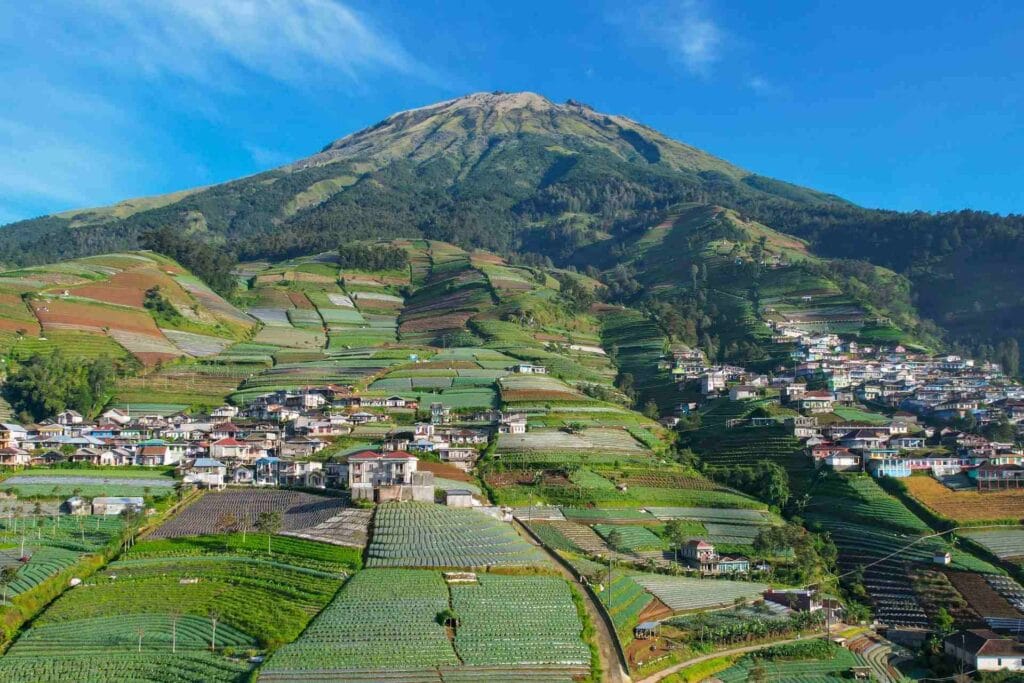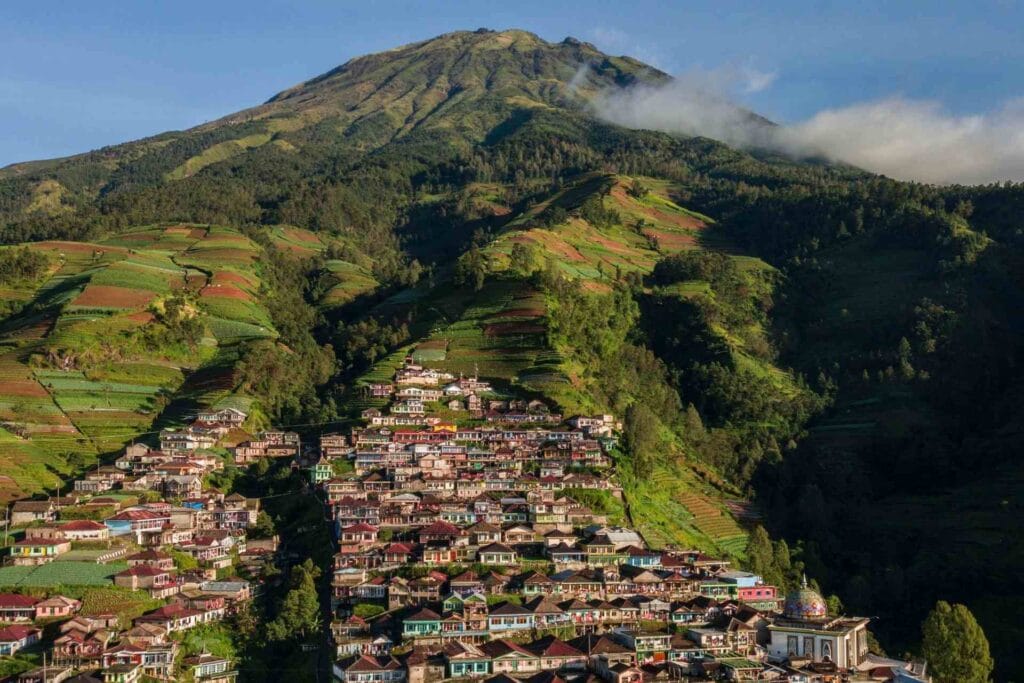If you’re searching for a peaceful escape tucked away in the mountains of Central Java, Nepal Van Java might just be the hidden gem you’ve been looking for. With its colorful houses cascading down the hillside, fresh mountain air, and panoramic views of Mount Sumbing, this rural village has captured the hearts of travelers and photographers alike.
Nicknamed for its resemblance to Himalayan villages, Nepal Van Java offers more than just beautiful scenery. It’s a living village, where farming traditions meet slow-paced rural life, and every sunrise brings a new layer of magic. Whether you’re planning a quick stop or an overnight stay, this guide will help you make the most of your journey. Let’s explore everything you need to know about visiting Nepal Van Java—from how to get there, what to do, where to stay, and how to experience the culture respectfully.
1. What Is Nepal Van Java?
Nepal Van Java is a vibrant mountain village located on the slopes of Mount Sumbing in Central Java, Indonesia. With its rows of colorful houses, cool weather, and terraced hills, the village has become a rising tourism star—often dubbed the “Nepal of Java” because of its stunning mountain backdrop and high-altitude location. In recent years, Nepal Van Java has transformed from a quiet agricultural village into a favorite spot for travelers, photographers, and nature lovers looking for authentic rural life and scenic beauty. This Nepal Van Java travel guide will help you plan your visit, learn what makes the village special, and connect with local life while supporting the community.
2. Where Is Nepal Van Java Located?
Nepal Van Java is located in the Butuh Village, Kaliangkrik District, in Magelang Regency, Central Java. It sits at an elevation of approximately 1,600 meters above sea level, making it one of the highest villages in the region. It is nestled on the western slope of Mount Sumbing, Indonesia’s third-highest volcano. The cool temperatures, foggy mornings, and surrounding green hills make it a perfect retreat from the city.
3. Why Is It Called “Nepal Van Java
The nickname “Nepal Van Java” (Dutch for “Nepal of Java”) began as a local branding initiative to attract tourism. It reflects the similarities between the village’s appearance and some Himalayan villages in Nepal—both characterized by:
- Colorful hillside homes
- Steep terrain and terraced farming
- Misty mornings and mountain peaks
- Friendly and humble communities
Though it has no official ties to Nepal, the nickname has become so popular that it’s now used in signage, tour names, and social media hashtags.
4. Best Time to Visit Nepal Van Java
The best time to visit Nepal Van Java is during the dry season, from May to September, when skies are clearer and the risk of landslides is low. Morning visits (6 AM to 7 AM) offer the best light for photography and sunrise views. Avoid rainy season (November to March), as fog and rain can limit visibility. Many travelers combine a visit with nearby attractions like Dieng Plateau or Borobudur, making it a great stop on a Central Java tour.
5. How to Get to Nepal Van Java
🛣️ From Yogyakarta (approx. 2.5–3 hours):
- Drive or hire a private car
- Route: Yogyakarta → Magelang → Kaliangkrik → Butuh Village
🚗 From Borobudur (approx. 1.5 hours):
Public transport is limited, so hiring a private driver is recommended. You can also book a village tour with local guide support and flexible timing.

6. What to Do in Nepal Van Java
Nepal Van Java is not packed with commercial attractions, which is exactly its charm. Most activities are Scenic Walks & Hiking like Explore the slopes of Mount Sumbing or join a guided trek. Visit local farms and watch traditional farming methods. Some people also prefer village exploration where they walk around the colorful alleys and interact with friendly locals.
7. Photography & Instagram Spots
One of the reasons Nepal Van Java became popular is its photogenic layout. Don’t miss:
Main Viewing Platform (Gardhu Pandang): Classic viewpoint overlooking colorful rooftops and Mount Sumbing.
Terraced Gardens: Fields with vegetables or flowers depending on the season
Drone Shots: Capture the full village on the hillside (ask permission and avoid sunrise hours to not disturb others)
Foggy Streets at Sunrise: For a mystical look that rivals photos from Nepal itsel
8. Cultural Experiences in the Village
Besides nature, Nepal Van Java offers authentic cultural charm. Expect:
- Traditional Javanese hospitality
- Community events, harvest rituals, and mosque gatherings
- Simple life rhythms—people waking at dawn, working on farms, gathering in small warungs (cafés)
You may be invited for a cup of tea or a conversation with a local elder—these moments are highlights for many travelers.
📌 Join a village tour to make deeper connections.
9. Where to Stay and Eat
Local homestays are available for visitors who wish to stay overnight. Facilities are basic but clean and warm. Staying overnight lets you experience like Sunrise and early fog, Night sky photography, and community atmosphere
Recommended stays (as of this writing):
- Homestay Bu Lastri
- Homestay Pak Minto
- Villa Pandang Sumbing
Local Foods to Try:
- Mie ongklok (noodles in thick gravy)
- Tempe mendoan (crispy soybean snack)
- Teh tubruk (Javanese-style strong tea)
Meals are usually homemade and simple—ask your host to cook local dishes!
10. Tips for Travelers
Bring warm clothes – temperatures drop at night
Wear walking shoes – terrain can be steep and slippery
Bring cash – no ATMs in the village
Be respectful – this is a real community, not a tourist-only destination
Avoid drones early in the morning – locals value peace during prayer and farming hours
Book a guide – they’ll show you hidden viewpoints and explain local culture
1. Where exactly is Nepal Van Java located?
Nepal Van Java is located in Butuh Village, Kaliangkrik District, in Magelang Regency, Central Java, Indonesia. The village sits on the western slope of Mount Sumbing, about 1,600 meters above sea level. It’s approximately a 2.5 to 3-hour drive from Yogyakarta and 1.5 hours from Borobudur Temple. For the most convenient access, travelers are recommended to hire a private driver or book a local village tour.
2. Do I need to book in advance to visit Nepal Van Java?
You don’t need a ticket or official reservation to enter Nepal Van Java, but it’s highly recommended to book a local homestay or guide in advance, especially on weekends or during national holidays. This ensures availability for accommodation and helps you enjoy the experience more comfortably. If you plan to explore deeper trails or viewpoints, a local guide can show you hidden spots safely.
3. Is Nepal Van Java suitable for family or beginner travelers?
Yes! Nepal Van Java is a great destination for families, beginner hikers, and slow travelers. The village atmosphere is peaceful, the locals are friendly, and most walking paths are manageable. That said, the terrain is hilly, so wearing comfortable walking shoes and bringing warm clothing is advised. Families often enjoy staying overnight to catch the beautiful sunrise and experience authentic village life.



